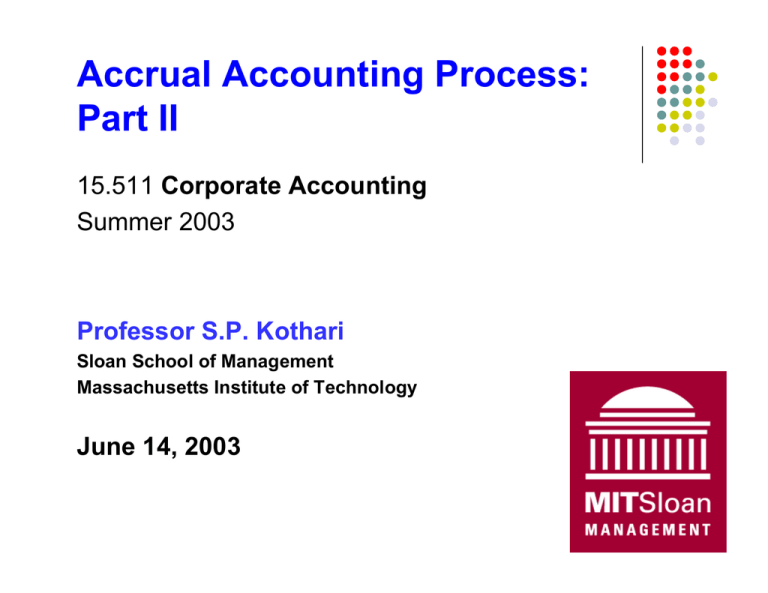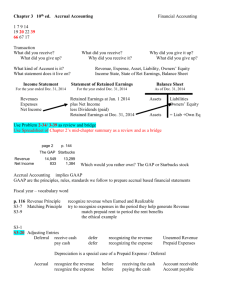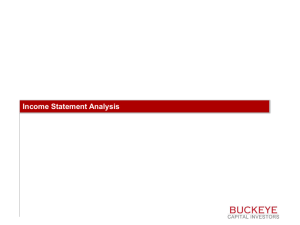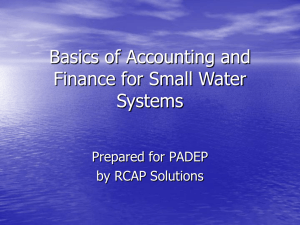Accrual Accounting Process: Part II Corporate Accounting Summer 2003
advertisement

Accrual Accounting Process: Part II 15.511 Corporate Accounting Summer 2003 Professor S.P. Kothari Sloan School of Management Massachusetts Institute of Technology June 14, 2003 1 Agenda for Today Continue with the accrual process Intuition Mechanics Too many slides and a lot of details! Some of these are for self-study and for recitations 2 Cash Flow Versus Accrual Accounting Cash flow accounting Measures performance by comparing the cash inflows of a certain time period to the cash outflows of that period (e.g., cash flow from operations). Accrual accounting Measures performance by comparing revenues (which are recognized when the earning process is complete) with expenses (which are recognized when assets are consumed or liabilities are created). Geared toward periodic performance measurement that is not skewed by investment, financing, and long-horizon operational activities 3 Cash Flow Versus Accrual Accounting Accrual accounting Based not only on cash transactions but also on credit transactions, barter exchanges, changes in prices, changes in form of assets or liabilities, and other transactions. Records events that have cash consequences for an enterprise But does not require a concurrent cash movement in order to record a transaction. 4 Cash Flow Versus Accrual Accounting Over the entire life of a corporation, total “income” under cash flow and accrual accounting is the same. However, cash receipts in a particular period may largely reflect the effects of activities of the enterprise in earlier periods. Similarly, many of the cash outlays may relate to activities and efforts to be undertaken in future periods. The matching principle in accrual accounting addresses this limitation of cash flow accounting. 5 Cash Flow Versus Accrual Accounting Isn’t cash flow more important than earnings? What cash flows are important? Future cash flows! When compared to current cash flows, current earnings are more highly associated with future cash flows 6 Cash Flow Versus Accrual Accounting Stock price = Present value of expected future cash flows. What is “Present Value?” Changes in stock prices = f(changes in expectations about future cash flows). When compared to cash flows, earnings have a stronger association with stock prices. Earnings are superior indicators of expected future cash flows. 7 Accounting Earnings versus Stock Prices Top management’s incentive compensation is usually linked to stock prices and accounting earnings. Why not link it to stock prices alone? Stock prices are affected by economic factors that are outside of a manager’s control (e.g., macroeconomic, political factors). Consequently, stock prices may be a poor indicator of managerial performance. Combining both mitigates this problem 8 Accounting Earnings versus Stock Prices A second reason for using accounting earnings Expected versus delivered performance Firm X hires manager Y on December 31, 1997. Stock price of X jumps by 10%! Why? Market’s expectations regarding the company’s future performance improve. Accounting earnings of 1998 increases by 10%! Why? Manager Y’s actions produce an actual improvement in the financial performance of X in 1998. Stock prices anticipated this improvement in 1997 at the time of the earnings announcement. 9 Accounting Earnings versus Stock Prices By combining stock prices and earnings to reward managers, a firm can reward a manager for his/her strategic planning and operational execution. Of course, stock prices do reflect the delivered performance of the manager as well. But if payment is on the basis of expected performance, then what do you do if the manager shirks subsequently? (Moral hazard problem) Earnings provide a straightforward measure of delivered performance. 10 Accrual Accounting and Periodic Adjustments Accountants record exchange transactions. But this does not capture all economic activities. Periodic adjusting Required to record activities that have taken place, but which have not yet been recorded. To reduce accounting costs Some economic activities may be continuous in nature. The effect of such activities are accumulated over a period and then recorded periodically rather than continuously, e.g., consumption of stationary. 11 Accrual Accounting and Periodic Adjustments In many cases, assets and liabilities are created or discharged without the occurrence of a visible, documented exchange transaction Interest is earned continually on a bank savings account as time passes Machinery depreciates as it is used in a company's operations. Periodically, adjusting journal entries are made to record these effects. 12 Accrual Accounting and Periodic Adjustments Adjusting entries Made whenever financial statements are prepared. Why? Adjusting entries are designed to Correctly compute periodic income Correctly show balances of assets and liabilities at the end of the period Will there be a need for adjusting entries if a corporation prepares only one income statement for the period covering its whole life? 13 Periodic Adjustments Characteristics of an adjusting journal entry: matching of expenses and revenues involves at least one temporary (revenue, expense, or dividend) account and at least one permanent (asset or liability) account. never involves the cash account 14 s Four ways that recognition and cash do not coincide Pay Cash Recognize Expense Time Balance Sheet Date Recognize Expense Pay Cash Time Balance Sheet Date 15 s Four ways that recognition and cash do not coincide Receive Cash Recognize Revenue Time Balance Sheet Date Recognize Revenue Receive Cash Time Balance Sheet Date 16 Types of Periodic Adjustments Expense or Revenue before Cash Expense incurred today, but cash paid tomorrow. Salary earned by employees but not paid at the end of accounting period. Employees earn salary when they perform their duties, not when they receive payment. Unpaid salary is a Salary Payable liability Revenue earned today, but cash received tomorrow Interest earned today, but cash received tomorrow. Interest is a reward for lending money, so it is earned with passage of time Interest receivable asset 17 Types of Periodic Adjustments Cash before accruing Revenue or Expense (Cost Expirations or Revenue Expirations) Cash paid yesterday, Expense incurred today. 1998 rent paid in advance in 1997 Rent paid in advance asset Cash received yesterday, revenue earned today Cash advance from customer for services not yet performed Cash advance is Unearned Revenue liability Matching is the guiding principle in periodic adjustments. Objective: To match the revenue earned in a period (whether received in that period in cash or not) with all the expenses incurred to earn that revenue (whether paid in that period in 18 cash or not). Accruals (Accrue Today, Cash Tomorrow) Accrued Wages Employees of Sloan Enterprises are paid at the end of each week. The total weekly payroll is $10,000, which is earned at a rate of $2,000 per day for each of the five working days. Assume December 31 falls on a Tuesday Books are closed (financial statements are prepared) on that December 31. On December 31 Sloan Enterprises has incurred wage expense for two days But will not pay it in cash until January 3rd of the next fiscal year. 19 Accruals (Accrue Today, Cash Tomorrow) Periodic adjustment on December 31 Assets = Liabilities + Owners’ Equity Wages Payable Retained Earnings +4,000 -4,000 Dr Wage Expense (-RE) 4,000 Cr Wages Payable (+L) 4,000 Effect of omitting this journal entry? Liabilities are understated by $4,000 Retained earnings & Net income overstated by $4,000 20 Accruals (Accrue Today, Cash Tomorrow) What would you see on the balance sheet as of 12/31? Wages Payable $4,000 under Liabilities What would you see on the income statement for the year ended 12/31? Wage Expense of $520,000 52 Weeks x $10,000 per week Wage expense would have been $4,000 less. Expense would have been understated Net income overstated Without the adjusting entry 21 Accruals (Accrue Today, Cash Tomorrow) $10,000 paid on Jan. 3 of next year. Assets = Liabilities + Owners’ Equity Cash Wages Payable Retained Earnings -10,000 -4,000 -6,000 Dr Wage Expense (-RE) 6,000 Dr Wages Payable (-L) 4,000 Cr Cash (-A) 10,000 What would be the balance in the T-account for Wage Expense on January 3rd? $6,000 22 Accruals (Accrue Today, Cash Tomorrow) Consider the $10,000 paid to the employees. Where and How would it show up in the financial statements? Period 1 Cash Flow Statement Operating cash flow Income Statement Wage expense (-RE) Period 2 -10,000 -4,000 -6,000 23 Accruals (Accrue Today, Cash Tomorrow) Accrued Interest On December 1, U.S. Bank loans $24,000 to Stone Corporation at an annual interest rate of 10%. Books are closed on December 31 Stone Corp. pays U.S. Bank in full (principal and interest) on January 31 of the next year. Assets Cash Loan Receivable -24,000 +24,000 Dr Loan Receivable (+A) Cr Cash (-A) = L + OE 24,000 24,000 24 Accruals (Accrue Today, Cash Tomorrow) Where would you see this in the cash flow statement of U.S Bank? Investing out flow of $24,000 On December 31, U.S. Bank has earned one month’s interest on the loan given to Stone Corp. Interest earned = 24,000 x 10% x 1/12 = $200. 25 Accruals (Accrue Today, Cash Tomorrow) Periodic adjustment on December 31 Assets = L + Owners’ Equity Interest Receivable Retained Earnings +200 +200 Dr Interest Receivable (+A) 200 Cr Interest Revenue (+RE) 200 Effect of omitting this journal entry? Assets are understated by $200 Retained earnings & Net income each understated by $200 26 Accruals (Accrue Today, Cash Tomorrow) How much cash will U.S. Bank receive on January 31 of the next year? $24,000 -- amount lent to Stone Corp. (principal) Plus $400 as interest for 2 months Although a single check may be issued, let us consider it as two transactions. Assets Cash Loan Receivable +24,000 -24,000 = L + OE 27 Accruals (Accrue Today, Cash Tomorrow) Assets = L + Owners’ Equity Cash Int. Receivable Retained Earnings +400 -200 +200 Dr Cash (+A) 400 Cr Interest Receivable (-A) 200 Cr Interest Revenue (+RE) 200 Two elements to the journal entry Exchange of one asset for another asset Record revenue earned and cash received 28 Accruals (Accrue Today, Cash Tomorrow) Effect on cash flow and income statements Period 1 Period 2 Cash Flow Statement Investing cash flow -24,000 +24,000 Operating cash flow +400 Income Statement Interest Revenue +200 +200 29 Cost Expirations (Cash Yesterday, Accrual Today) Supplies Inventory During 2000, Greener Pastures, Ltd. purchases (for cash) supplies in the form of spare parts to support the manufacture of farm machinery at a total cost of $700. The company began the year with $500 in the supplies account. Assets Cash -700 = Liabilities + OE Supplies +700 30 Cost Expirations (Cash Yesterday, Accrual Today) On December 31, a count reveals that supplies in the amount of $300 remain on hand. Supplies Used = Beg. Inv. + Purchases - Ending Inventory = $500 + $700 - $300 = $900 Assets = L + Supplies -900 Dr Supplies Expense (-RE) Cr Supplies Inventory (-A) Owners’ Equity Retained Earnings -900 900 900 31 Cost Expirations (Cash Yesterday, Accrual Today) Supplies Account Beg bal Purchases Ending Inv 500 900 Supplies expense 700 300 Supplies expense of $900 is the adjusting entry and the corresponding debit is to Retained Earnings (i.e., expense on the income statement that affects retained earnings). The Ending Inventory of $300 appears on the balance sheet (and it serves as the ending inventory for the current fiscal period and beginning inventory for the following fiscal period). 32 Cost Expirations (Cash Yesterday, Accrual Today) What shows up in the cash flow statement? The cash paid during the year for purchase of supplies Operating outflow = $700 The cost of supplies consumed during the year Supplies expense = $900 Ending balance in Supplies of $300 What shows up in the income statement? What shows up in the balance sheet? 33 Cost Expirations (Cash Yesterday, Accrual Today) Prepaid Expenses On January 1, 1999, Crimson Inc. purchased a $1,000 insurance premium for a two-year period January 1, 1999 Assets = L + OE Cash Prepaid Insurance -1,000 +1,000 Dr Prepaid Insurance (+A) 1,000 Cr Cash (-A) 1,000 34 Cost Expirations (Cash Yesterday, Accrual Today) What happens during 1999? One-year’s worth of insurance protection expires How to record this in financial statements? Assets = L + Owners’ Equity Prepaid Insurance Retained Earnings -500 -500 Dr Insurance Expense (-RE) 500 Cr Prepaid Insurance (-A) 500 Effect of omitting this journal entry? Assets are overstated by $500 Retained earnings (income) overstated by $500 35 Cost Expirations (Cash Yesterday, Accrual Today) Reporting in Financial Statements? 1999 Operating cash out flow (-) 1,000 Insurance expense (-RE) 500 2000 500 What shows up in the balance sheet as of 12/31/99? Assets: Prepaid Insurance $500 Why is this an asset? Represents one-year’s worth of insurance protection for 2000 available to the company 36 Cost Expirations (Cash Yesterday, Accrual Today) Are we not getting insurance protection every day? Why wait till December 31 to record the expense? Cost-benefit trade off Financial statements are prepared quarterly for investors and monthly for firm’s management. The adjusting entries may be recorded more frequently. 37 Cost Expirations (Cash Yesterday, Accrual Today) Pre-received revenues Unearned revenue Fees received in advance Customer advances Subscription received in advance, etc. Magazines Unlimited receives $5,000 during 2000 for magazine subscriptions to be fulfilled during 2000 and 2001. Assume that as of the end of 2000 Time had fulfilled 60% of the subscriptions. 38 Cost Expirations (Cash Yesterday, Accrual Today) $5,000 received during 2000 Assets = Liabilities + OE Cash Unearned Revenue +5,000 +5,000 Dr Cash (+A) 5,000 Cr Unearned Revenue (+L) 5,000 What happens to this liability at the end of 2000? Decreases by 60% because Magazines Unlimited delivers magazines in 2000. 39 Cost Expirations (Cash Yesterday, Accrual Today) Assets = Liabilities + Owners’ Equity Unearned Revenue Retained Earnings -3,000 +3,000 Dr Unearned Revenue (-L) 3,000 Cr Subscription Revenue (+RE) 3,000 Effect of omitting this entry? Liabilities are overstated by $3,000 Retained earnings (income) understated by $3,000 40 Cost Expirations (Cash Yesterday, Accrual Today) Effect on financial statements? 2000 2001 Operating cash inflow (+) +5,000 Subscription revenue (+RE) +3,000 +2,000 What do you see in the balance sheet as of 12/31/2000? Liabilities: Unearned Revenue = $2,000 Represents the obligation for unfulfilled journal subscriptions. 41 Cost Expirations (Cash Yesterday, Accrual Today) Depreciation Dewey, Inc. invests $10,000 in a quality control equipment on January 1, 1990. Dewey’s management estimates initially that the equipment would last for ten years and would be scrapped thereafter. Assets = Cash Equipment -10,000 +10,000 Dr Equipment (+A) Cr Cash (-A) L + OE 10,000 10,000 42 Cost Expirations (Cash Yesterday, Accrual Today) Where and when would you see the $10,000 in the cash flow statement? Investing cash outflow of $10,000 in the year of payment Dewey paid for the equipment in 1990, but the equipment provides benefits for 10 years. What does matching principle suggest? Apportion the $10,000 as an expense over the 10 year period Depreciation expense 43 Cost Expirations (Cash Yesterday, Accrual Today) Depreciation is allocating (or expensing) the cost of a long-lived asset over its estimated useful life. How much to allocate to a given period as depreciation expense? Several methods are allowed under GAAP (Discussed later in the course). One common method is straight line Equal apportionment of the cost over useful life 44 Cost Expirations (Cash Yesterday, Accrual Today) Depreciation expense for each year = $1,000 At the end of each year, what do we do? Assets = L + Owners’ Equity Equipment Retained Earnings -1,000 -1,000 If we repeat this ten times over the next ten years, what would be the balance in the T-account for Equipment Zero 45 Cost Expirations (Cash Yesterday, Accrual Today) How does the $10,000 show up in the cash flow and income statements? Periods 1 2 3 ...... 10 Investing outflow (-) 10,000 0 0 …… 0 Depreciation Exp. (-RE) 1,000 1,000 1,000 ... 1,000 Over a firm’s entire life, would net income be equal to its operating cash flows? No, operating cash flow does not include the outflow for equipment whereas net income is computed after subtracting depreciation expense 46 Cost Expirations (Cash Yesterday, Accrual Today) How to record depreciation expense? Equipment Retained Earnings -1,000 -1,000 One possibility is Dr Depreciation Expense (-RE) 1,000 Cr Equipment (-A) 1,000 However, this is not GAAP. What might be the potential limitations of this approach? 47 Cost Expirations (Cash Yesterday, Accrual Today) Consider two Companies Company A Company B Equipment 10,000 10,000 Instead of this disclosure, let us consider an alternative approach Equipment (cost) 100,000 20,000 (-) Depreciation to date (90,000) (10,000) Net Book Value 10,000 10,000 What do you learn from the second approach? 48 Cost Expirations (Cash Yesterday, Accrual Today) How do accountants record depreciation? Dr Depreciation Expense (-RE) 1,000 Cr Accumulated Depreciation (-A) 1,000 Acc. Dep. is a contra (negative) asset account Decreases in assets are credits So, Acc. Dep. has a credit balance Represents the cumulative depreciation on an asset Informs the user about the age of the asset 49 Cost Expirations (Cash Yesterday, Accrual Today) Balance sheet presentation after one year. Equipment (original cost) 10,000 (-) Accumulated Depreciation (1,000) Net Book Value 9,000 Balance sheet presentation after ten years. Equipment (original cost) 10,000 (-) Accumulated Depreciation (10,000) Net Book Value 0 Does this make sense? 50 Cost Expirations (Cash Yesterday, Accrual Today) Yes, if the asset remains in use. Sometimes fully depreciated asset may still be used. However, if the equipment is scrapped after ten years, how do we record it? Eliminate it from the books Dr Acc. Depreciation (+A) 10,000 Cr Equipment (-A) What remains on the books? Equipment (-) Accumulated Depreciation Net Book Value 10,000 0 0 0 51 Summary Accrual accounting can be confusing! Understand the logic behind it and it will be clear. 52



